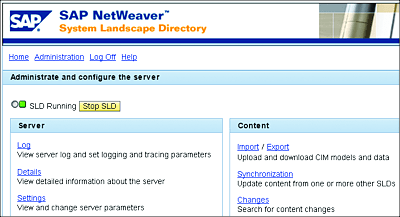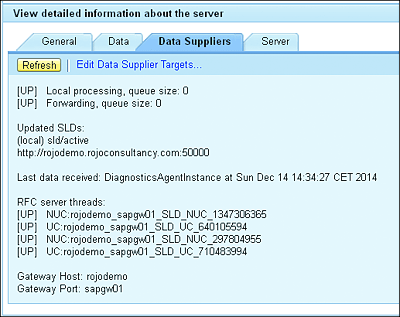3.3 Administration of the System Landscape Directory
In this section, we’ll explore some administrative functionalities of the SLD, focusing on those functionalities that are commonly used and relevant to an SAP PO installation. The main page used for the administration of your SLD can be reached by clicking on the Administration menu link from the System Landscape Directory landing page. From this page, you can distinguish the server and content categories, which will be explored in this section.
3.3.1 Server
This category contains applications that expose different aspects of the SLD server. We’ll explore each application.
Status of the System Landscape Directory
To view the current status of the SLD, whether it’s currently running or not, check the traffic light on the top left of the SLD Administration screen (see Figure 3.14).
Figure 3.14 SLD Administration Screen
Like any conventional traffic light, a green light will mean that your SLD is up and kicking, whereas a red light will indicate that it’s down and might require manual action.
Stop or Start the System Landscape Directory
You can temporarily stop or start the SLD using either the Stop SLD or Start SLD button, located at the right side of the traffic light (refer to Figure 3.14).
Log
With this logging functionality, you can view the SLD server logs. From this page, for example, you could get more details about failing data imports or exports. It’s also possible to set logging and tracing parameters here.
Details
From the Details page, it’s possible to see all detailed information about your SLD server. As shown in Figure 3.15, the following details are displayed:
-
General
This tab contains details of the SLD such as running statuses, versions, SAP Java Virtual Machine (SAP JVM) memory, JVM version, Java system properties, and so on. -
Data
This tab contains CIM-related totals and information such as counts of CIM classes, instances, and associations. -
Data Suppliers
This tab has details about the data supplier and which other SLDs are being updated by the local SLD. Figure 3.15 shows that the local SLD server is forwarding data to another (central) SLD. -
Server
This tab has information such as CIM service version, utilization capacity, hit rate, and so on.
Figure 3.15 SLD Administration Details Page and Available Information
3.3.2 Data and Content
Data and content can be added to the SLD via three different options: data import, system self-registration, and manual creation of data.
Import and Export
This functionality enables the import of the CIM and data from a local file. You can also export the CIM and data of the current SLD via the export functionality.
You can use the export function to perform a full backup of the current SLD data. It’s also possible to perform an incremental export. Incremental exports only export the delta objects that were added to the SLD since the last time an export happened. As such, the incremental method of performing an export requires good administration.
Synchronization
If you have multiple SLDs, and you need to keep their content in sync, then you might opt to synchronize them or to transport the content between the different SLDs. It’s then possible to choose between a fully automated synchronization and a manual synchronization. The synchronization of SLD content will be broadly explored in Section 3.4, when we discuss the different SLD strategies. During a typical synchronization, the data and content from one source SLD are propagated to another target SLD.

